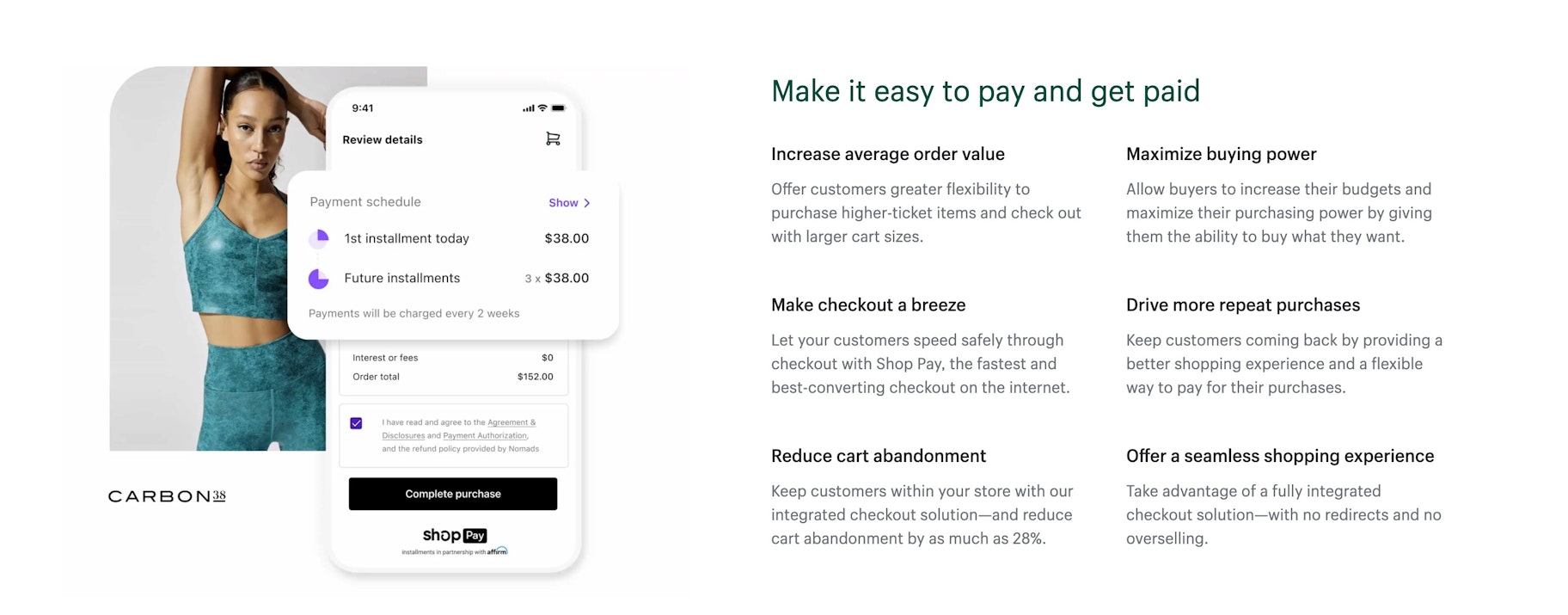It’s an understatement to say that things have changed lately. Some businesses are finding themselves more successful than ever, while some are still reeling from the damage the pandemic has brought.
So as a small business owner, it’s perfectly natural for you to be doing your research, keeping up on news and trends, and trying to prepare yourself for what the future might hold.
And you’re in luck. We’ve combed through recent research so you don’t have to do all the legwork. In this article, we’re going to look at seven of the most important trends for you to keep on your radar in 2022 and beyond.



7 small business trends for 2022
1. Offer buy now, pay later options
Over the past few years, buy now, pay later (BNPL) has gone from a payment option exclusively offered by large retailers to a common sight at checkouts of many businesses around the globe. Affirm, a US-based BNPL company, reported that the number of active merchants on its platform increased from 6,500 to 102,000 from July to September of 2021. Likewise, BNPL providers in other countries reported a sharp increase in user volume.
The rapid-fire adoption of the BNPL trend comes from the need for small businesses to attract younger shoppers and stimulate impulse purchases. According to eMarketer, 44% of Gen Z and 37% of millennials are expected to make a BNPL payment in 2022. It’s a payment type that offers convenience to shoppers while growing revenue, with many businesses offering BNPL reportedly seeing an improvement in sales and competitive standing.
→ Click Here to Launch Your Online Business with Shopify
If you want to let customers buy now, pay later, you can do so with solutions like Shop Pay. An accelerated checkout for Shopify stores, Shop Pay gives your customers the option to pay in full or split their purchase into four equal interest-free payments. There are no jaw-dropper charges or even late fees passed on to customers.

2. Prioritize online sales—including marketplaces
Even for those with a brick-and-mortar presence, small business trends show that online sales are crucial for driving revenue and business growth.
In Shopify’s 2022 Future of Commerce report, researchers cited data that 54% of businesses acknowledged the importance of focusing on online revenue for achieving their priorities. Going deeper, 49% of businesses stated they plan to invest more in their company-owned online store. Got an online store of your own? Evaluate its design to see if there are any areas that could be improved with a little cash injection.
Businesses also acknowledged the importance of online marketplaces, with 56% saying they plan to increase their investment in such platforms. This can be highly beneficial from a sales perspective, as 55% of consumers said they buy from online marketplaces either weekly or monthly. If you decide to invest in ecommerce marketplaces, consider building your presence across multiple top marketplace websites.
3. Embrace live commerce
One of the most fascinating small business trends is founders endorsing their offerings on an interactive livestream that enables consumers to shop for products in real time. It’s got a cool name: live commerce. And it’s projected to generate an estimated $25 billion in US sales by 2023.
Live commerce first took off about five years ago in China. Now, it’s paving the way for businesses in other countries to deliver unique customer experiences. One thing that’s apparent? Regardless of the location, live commerce returns higher engagement and higher conversion rates than other forms of electronic selling.
Just look at the example of Canadian shoe retailer Aldo, which registered 17,000 page views and got a 308% engagement rate on its site in the first five days after hosting a live shopping event last year. Plus, according to McKinsey, companies implementing live commerce saw conversion rates of close to 30% while also seeing a modest increase in their share of younger audiences—primarily millennials and Gen Z.
Want to use live commerce to your advantage? Sign up on a livestream shopping platform like TalkShopLive and showcase your products to get sales going. If you have a Shopify store, installing one of these apps will help you provide an interactive real-time shopping experience to customers.
4. Increase average over value by offering free shipping
Amid a shipping landscape profoundly altered by Amazon’s quick, free delivery, consumers are increasingly expecting cost savings when they opt to get their purchases delivered.
According to Jungle Scout’s Q1 2022 Consumer Trends Report, shipping price plays a critical role in online shoppers’ buying decisions, even more so than the product price. Researchers also identified free shipping as an important factor in increasing average order value and basket size. In the report, they say 58% of consumers make sure to spend enough money to qualify for free shipping for online orders.
Free shipping is a proven tactic for increasing order values and conversion, but rising delivery costs make it difficult for small businesses to sustain. If you decide to offer free shipping, make sure to set a threshold that covers your standard shipping costs, customs duties, the cost of the products, and your profit margin.

5. Optimize your business for international shoppers
Online commerce has enabled businesses to reach consumers around the globe, and attracting buyers means being able to provide a stellar shipping experience. In fact, cross-border ecommerce is projected to make up 22% of ecommerce shipments of physical items in 2022.
Shipping is still a cause of concern, though, as revealed in Shopify’s 2022 Future of Commerce report. Forty-three percent of consumers said they don’t want to have to pay extra for international orders. Plus, they are worried about experiencing higher overall shipping costs or longer delivery wait times.
Fortunately, taking a few steps can help ease most concerns around international shipping. Shopify has tools to help you improve the cross-border shopping experience, including price adjustments for different markets and setting clear international shipping rates.
We also recommend being upfront about any additional fees so there are no surprises for customers. Also, be sure to include proper customs documentation in order to avoid issues on arrival. These documents tell customs officers at the destination location what is in the package, how much it costs, and whether it is a commercial item or gift.
6. Invest in solving supply chain issues
The pandemic has truly shown how supply chain hiccups can impact even small businesses.
Data from Shopify’s 2022 Future of Commerce report revealed that 40% of founders said they would be somewhat impacted by global supply chain delays, and 28% said they’d be strongly impacted. For consumers, additional shipping delays and costs topped the list of concerns, followed by delays in product manufacturing.
But rather than cutting costs to navigate these challenges, founders are investing in solutions for addressing them. Forty-five percent plan to invest in manufacturing capacity, 44% plan to invest in increasing the speed of their supply chain, and 44% plan to invest in improving collaboration with 3PL partners.
7. Adopt sustainable business practices
Both businesses and consumers are increasingly aware of the impact commerce has on our planet. So, it’s no surprise that companies are planning their operations with sustainability in the back of their minds.
According to Shopify’s 2022 Future of Commerce Report, 46% of businesses plan to invest in empowering consumers to easily recycle products, 39% plan to invest in using natural, recycled, or renewable materials, and 39% want to enhance the efficiency of their production process.
Investing in sustainability is a worthwhile decision. You can start with small steps as you strive to make a positive environmental impact, like offsetting carbon emissions, finding sustainable shipping partners, and using social media to run campaigns about sustainability.

Protect your small business with knowledge
Unfortunately, we can’t predict the future (bummer, we know). But we can look to the pros to get a better understanding of what’s going on right now and how it might play out as more time passes.
Hopefully with this small business trend breakdown, you’re feeling a sense of confidence or even relief—or, at the very least, now have a better understanding of the game plan you need to help make sure your business thrives in the coming weeks, months, and years.
Just remember: as long as you’re constantly learning, adapting, and optimizing, you’re in the best position possible.






